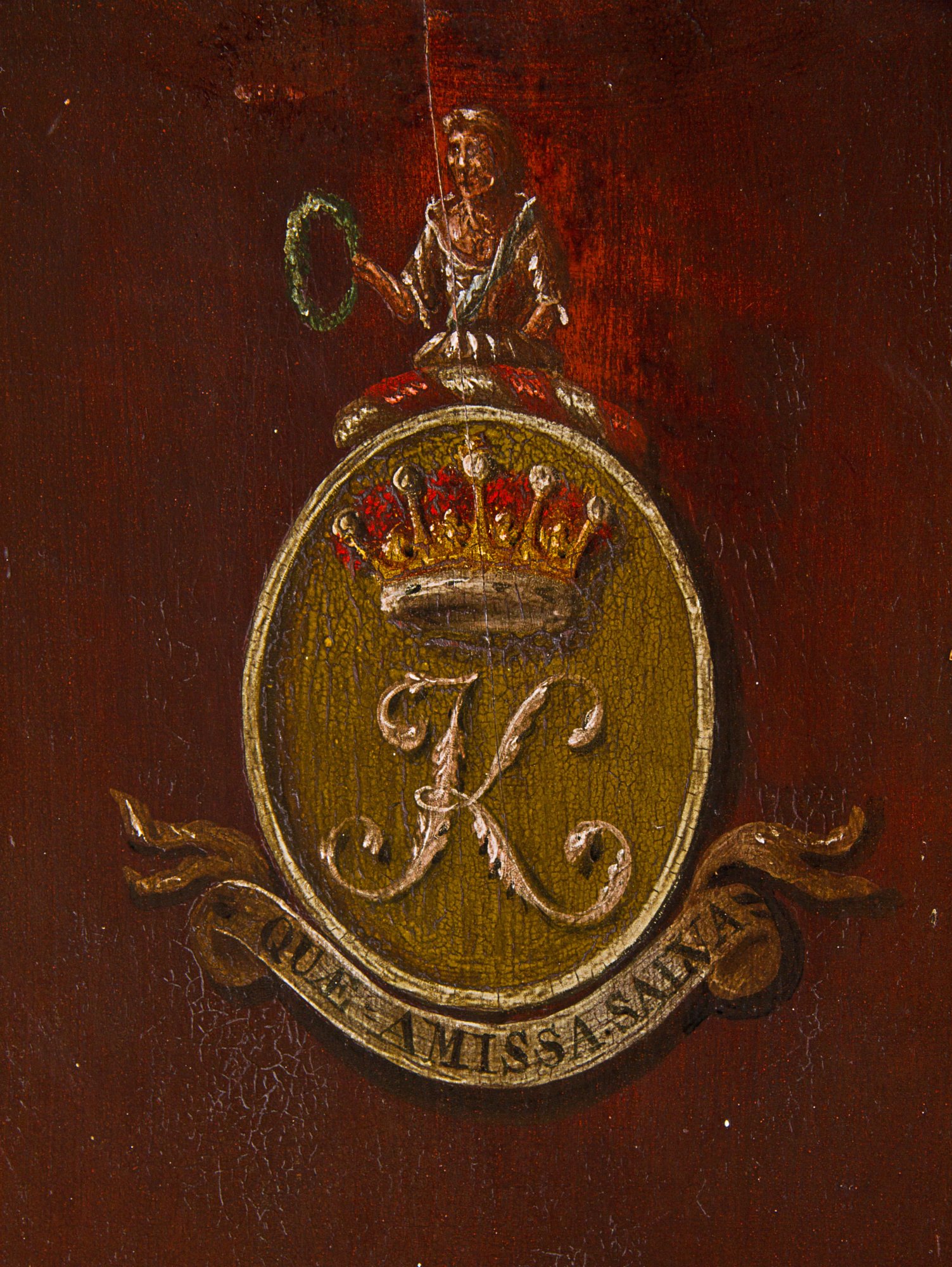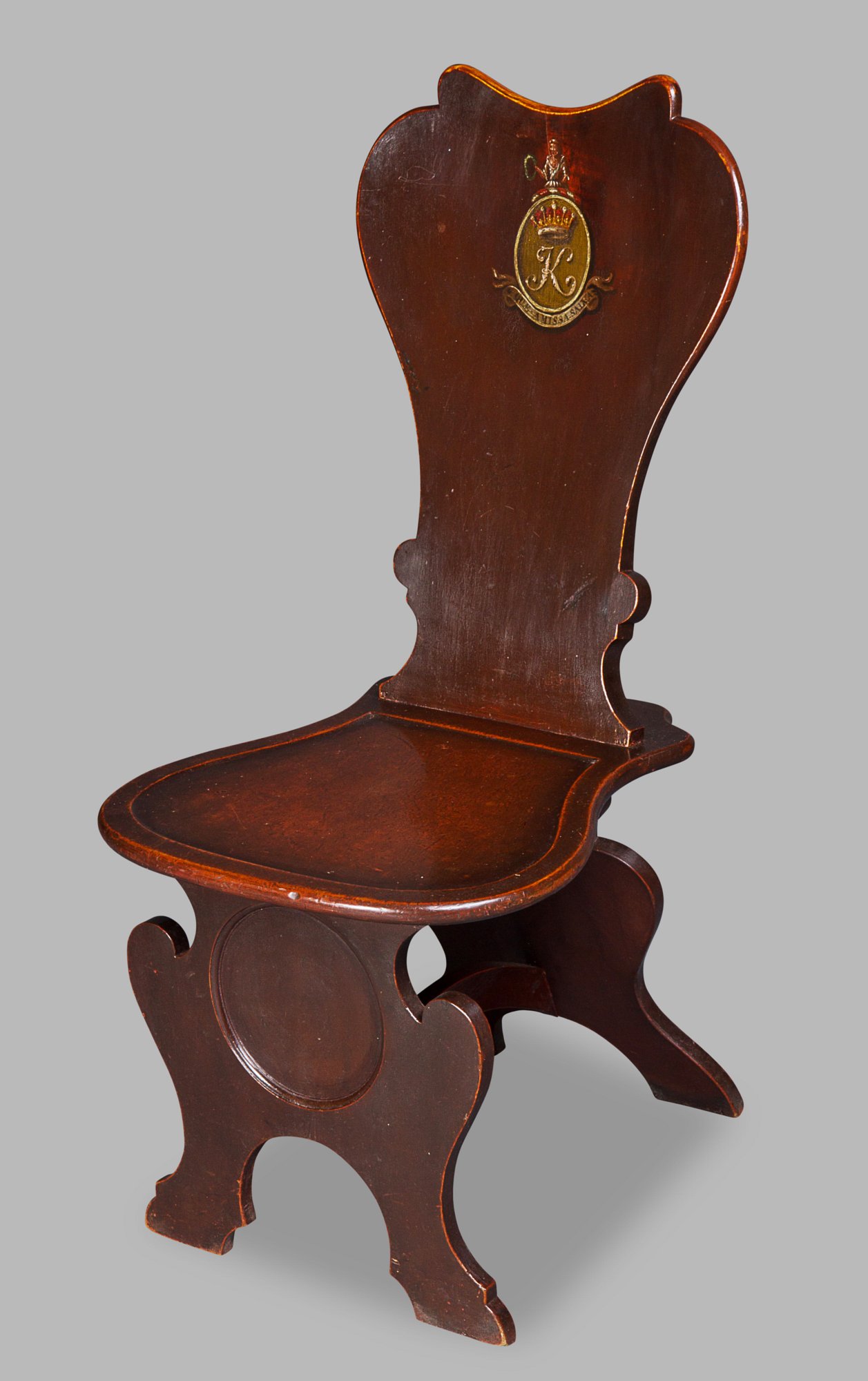



$12,500.00
18 ins wide, 22 1/4 ins deep and 39 ins high; Seat 16 3/4 ins high
For questions regarding viewing, shipping, and anything else,
contact us at: [email protected]
The design for this chair derives from Italian walnut Sgabelli of the 16th century that were popular throughout the Renaissance. Hall chairs of this general shape continued to be produced in the British Isles throughout the 18th century and well into the 19th century.
The current example is one of the finest we have seen, generously proportioned with a compass shaped dished seat, and arched trestle. This chair has a particularly graceful presentation, and is of the highest quality.
The back is painted with the crest, coronet, initial K and motto Quae Amissa Salva (What has been lost is safe) for the Scottish family Keith, Earls of Kintore , chiefs of Clan Keith and hereditary Earls Marischal of Scotland. The Earls Marischal of Scotland, equivalent to the Earl Marshals in England were hereditary custodians of the Royal Regalia of Scotland and were responsible for protecting the King’s person when attending Parliament. As chairs of this general design were produced over a long timespan, and without firm documentation, it is difficult to definitively ascribe a firm date for this chair and by extension suggest a commissioning patron within the Keith family. Although little is known of the furnishing of the Keith family estates, the aristocracy of Scotland is relatively small and noble families would most certainly have known each other and would be aware new furnishings and designs for the grand houses.
Foremost among the Scotish nobility the Crighton family, Earls of Dumfries constructed Dumfries House in Ayrshire, Scotland in the 1750s to a design by Robert and James Adam. The house was furnished by Thomas Chippendale and a number of Scottish craftsmen including Francis Brodie, Alexander Peter and William Mathie. Famously the house and contents were saved from dispersal by auction in 2007 by the intervention of Prince Charles and exist today as a protected Trust.
Amongst the furniture produced for Dumfries by Alexander Peter was a set of eight hall chairs invoiced in 1758, with the crests painted by John Bonner in 1759. These and the other items at Dumfries, invoiced by Peter are the only fully documented works known by this eminent Edinburgh maker and all other pieces suspected to be by him are by necessity attributed.

The present chair in our possession, the Kintore chair, is identical in construction, design and proportions to the Dumfries chairs leading to a possible attribution to Alexander Peters. In addition, the painting of the crest, motto and badge on the Kintore chair appears to have been executed by the same hand as the Dumfries chairs (presumably Bonner) further supporting the attribution. Whether the Dumfries chairs or Kintore chairs were produced by Alexander Peter first is clearly going to be debatable but it does give an indication that the general date of the present chair would probably be in the 1750s and therefor the probable commissioner can be ascertained. It is also worth quoting from Christie’s essay on the Dumfries set.
“ The evolution from a flat to a compass-fronted seat emerged during the 1750s, featuring on a set of twelve oak hall chairs of apparently identical profile supplied…..to the 2nd Duke of Atholl (died 1764) for Blair Castle, Perthshire in 175.….Hall chairs of this model executed for Scottish patrons are rare and those executed in Scotland are even rarer”. Essay on the Dumfries Hall Chairs, Christie’s Catalogue for Dumfries House, A Chippendale Commission, Volume 1, page 52, 12th July 2007.
Having established an approximate date for the manufacture of this chair there are a number of possibilities for the patron who commissioned it – John Keith, 3rd Earl of Kintore (1699-1758), his brother William Keith (1702-1761), 4th Earl of Kintore from 1758 to 1761 or their cousin George Keith, 10th Earl Marischal (1693-1778).
The least likely candidate is George Keith. An interesting character, he became Earl Marischal in 1712, but fought on the Jacobite side during the 1715 uprising, was charged with treason and forfeited his titles and estates to the crown. Exiled to Europe he developed a distinguished career as a diplomat for the Jacobite court in exile and then Prussia for Frederick the Great. Pardoned by George II in 1759 he regained his estates, visiting Scotland in 1761, but immediately sold them and returned to Prussia. Although he could earlier have ordered chairs for his newly reacquired estates, the painted crest, coronet and initial do not quite fit with accepted heraldry. Although he was entitled to an Earl’s coronet for his styling as Earl Marischal, the initial under the coronet would normally relate to the name of the title, in this case Kintore, and not Keith. George Keith on the death of his cousin, the 4th Earl in 1761 should have inherited the Kintore title but at that time, although pardoned, his right to inherit the title had not been reinstated so he was unable to use the Kintore imagery and we must exclude him as a possibility.
Without documentation it is impossible to choose between the two Earls of Kintore who may have commissioned this chair; the 3rd Earl, having inherited the title estates and Keith Hall, Inverurie, Aberdeenshire at age nineteen in 1718 is the strongest possibility, but the 4th Earl who inherited at exactly the time Dumfries had been furnished may well have commissioned a set of hall chairs on his accession and shouldn’t be discounted.
Scottish, c. 1750-1760